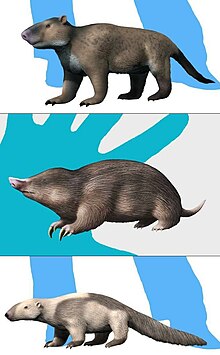Extinct clade of mammals
Palaeanodonta ("ancient toothless animals") is an extinct clade of stem-pangolins. They were insectivorous (myrmecophagous), possibly fossorial, and lived from the middle Paleocene to early Oligocene in North America, Europe and Asia.[3][5][6] While the taxonomic grouping of Palaeanodonta has been debated,[7] it is widely thought that they are a sister group to pangolins.[8][9][5][10]
Anatomy
Skull
Palaeanodonts generally have low and caudally-broad skulls, with notable lambdoid crests and inflated bullae and squamosals.[3]
Teeth
Despite the name of the group and contrary to their pangolin relatives, palaeanodonts are known to have had teeth.[11][3][10] Early palaeanodonts retained minimal tribosphenic post-canines while later species had peglike or otherwise reduced molar crowns.[11][3][10] Many also had large, characteristic cuspids.[11][10]
Classification and phylogeny
Traditional classification
- Order: †Palaeanodonta (Matthew, 1918) (stem-pangolins)[3]
Revised classification
- Order: †Palaeanodonta (Matthew, 1918) (stem-pangolins)[6]
- Family: †Epoicotheriidae (paraphyletic family) (Simpson, 1927)
- Genus: †Alocodontulum (Rose, 1978)
- †Alocodontulum atopum (Rose, 1977)
- Genus: †Amelotabes (Rose, 1978)
- †Amelotabes simpsoni (Rose, 1978)
- Genus: †Auroratherium (Tong & Wang, 1997)
- †Auroratherium sinense (Tong & Wang, 1997)
- Genus: †Dipassalus (Rose, 1991)
- †Dipassalus oryctes (Rose, 1991)
- Genus: †Tubulodon (Jepsen, 1932)
- †Tubulodon taylori (Jepsen, 1932)
- Subfamily: †Epoicotheriinae (paraphyletic subfamily) (Simpson, 1927)
- Genus: †Pentapassalus (Gazin, 1952)
- †Pentapassalus pearcei (Gazin, 1952)
- †Pentapassalus woodi (Guthrie, 1967)
- Genus: †Tetrapassalus (Simpson, 1959)
- †Tetrapassalus mckennai (Simpson, 1959)
- †Tetrapassalus proius (West, 1973)
- †Tetrapassalus sp. A [AMNH 10215] (Rose, 1978)
- †Tetrapassalus sp. B (Robinson, 1963)
- (unranked): †Epoicotherium/Xenocranium clade
- Genus: †Epoicotherium (Simpson, 1927)
- †Epoicotherium unicum (Douglass, 1905)
- Genus: †Molaetherium (Storch & Rummel, 1999)
- †Molaetherium heissigi (Storch & Rummel, 1999)
- Genus: †Xenocranium (Colbert, 1942)
- †Xenocranium pileorivale (Colbert, 1942)
- Family: †Ernanodontidae (Ting, 1979)
- Genus: †Asiabradypus (Nessov, 1987)
- †Asiabradypus incompositus (Nessov, 1987)
- Genus: †Ernanodon (Ting, 1979)
- †Ernanodon antelios (Ting, 1979)
- Family: †Escavadodontidae (Rose & Lucas, 2000)
- Genus: †Escavadodon (Rose & Lucas, 2000)
- †Escavadodon zygus (Rose & Lucas, 2000)
- Family: †Metacheiromyidae (paraphyletic family)[6] (Wortman, 1903)
- Genus: †Brachianodon (Gunnell & Gingerich, 1993)
- †Brachianodon westorum (Gunnell & Gingerich, 1993)
- Genus: †Mylanodon (Secord, 2002)
- †Mylanodon rosei (Secord, 2002)
- Subfamily: †Metacheiromyinae (paraphyletic subfamily)[6] (Wortman, 1903)
- Genus: †Metacheiromys (Wortman, 1903)
- †Metacheiromys dasypus (Osborn, 1904)
- †Metacheiromys marshi (Wortman, 1903)
- Genus: †Palaeanodon (Matthew, 1918)
- †Palaeanodon ignavus (Matthew, 1918)
- †Palaeanodon nievelti (Gingerich, 1989)
- †Palaeanodon parvulus (Matthew, 1918)
- †Palaeanodon sp. [Le Quesnoy] (Gheerbrant, 2005)
- Subfamily: †Propalaeanodontinae (Schoch, 1984)
- Genus: †Propalaeanodon (Rose, 1979)
- †Palaeanodon parvulus (Rose, 1979)
- Incertae sedis:
- Genus: †Arcticanodon (Rose, 2004)
- †Arcticanodon dawsonae (Rose, 2004)
- Genus: †Melaniella (Fox, 1984)
- †Melaniella timosa (Fox, 1984)
Phylogenetic tree
The phylogenetic relationships of order Palaeanodonta are shown in the following cladogram:[3][5][6]
| Ferae
|
|
†Epoicotherium/Xenocranium clade |
|
|
